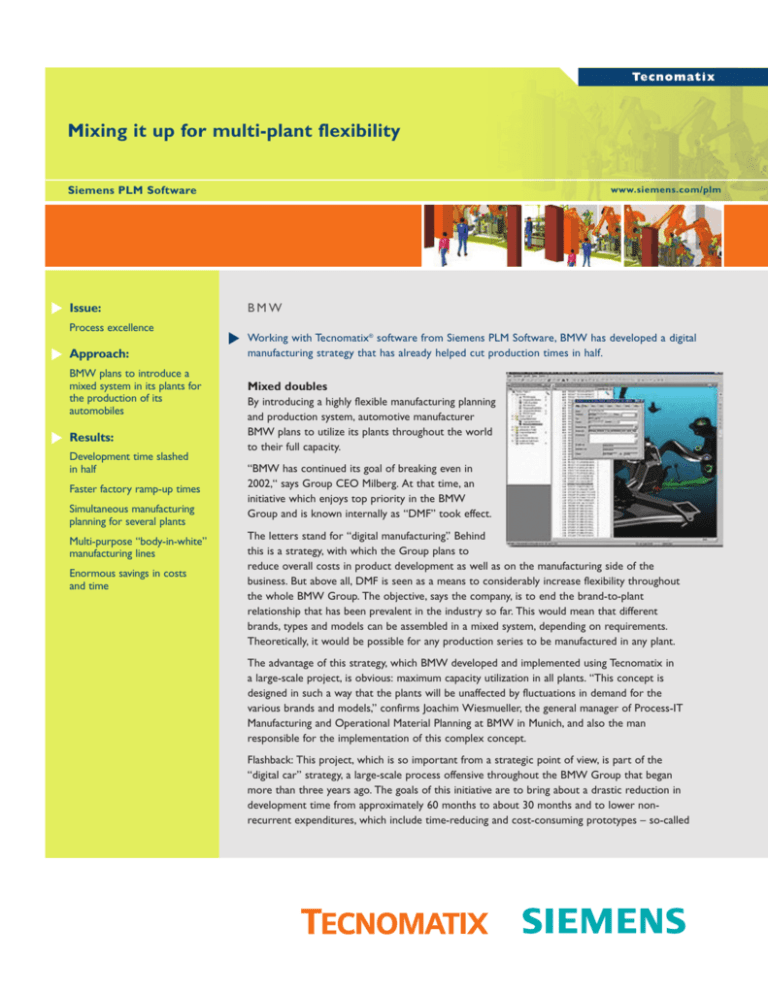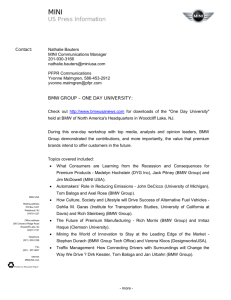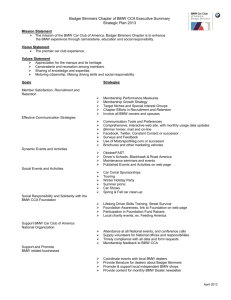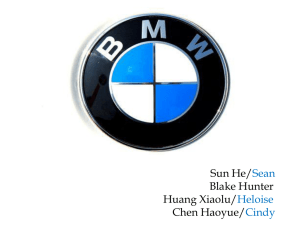
Tecnomatix
Mixing it up for multi-plant flexibility
Siemens PLM Software
Issue:
www.siemens.com/plm
BMW
Process excellence
Approach:
BMW plans to introduce a
mixed system in its plants for
the production of its
automobiles
Results:
Development time slashed
in half
Faster factory ramp-up times
Simultaneous manufacturing
planning for several plants
Multi-purpose “body-in-white”
manufacturing lines
Enormous savings in costs
and time
Working with Tecnomatix® software from Siemens PLM Software, BMW has developed a digital
manufacturing strategy that has already helped cut production times in half.
Mixed doubles
By introducing a highly flexible manufacturing planning
and production system, automotive manufacturer
BMW plans to utilize its plants throughout the world
to their full capacity.
“BMW has continued its goal of breaking even in
2002,“ says Group CEO Milberg. At that time, an
initiative which enjoys top priority in the BMW
Group and is known internally as “DMF” took effect.
The letters stand for “digital manufacturing”. Behind
this is a strategy, with which the Group plans to
reduce overall costs in product development as well as on the manufacturing side of the
business. But above all, DMF is seen as a means to considerably increase flexibility throughout
the whole BMW Group. The objective, says the company, is to end the brand-to-plant
relationship that has been prevalent in the industry so far. This would mean that different
brands, types and models can be assembled in a mixed system, depending on requirements.
Theoretically, it would be possible for any production series to be manufactured in any plant.
The advantage of this strategy, which BMW developed and implemented using Tecnomatix in
a large-scale project, is obvious: maximum capacity utilization in all plants. “This concept is
designed in such a way that the plants will be unaffected by fluctuations in demand for the
various brands and models,” confirms Joachim Wiesmueller, the general manager of Process-IT
Manufacturing and Operational Material Planning at BMW in Munich, and also the man
responsible for the implementation of this complex concept.
Flashback: This project, which is so important from a strategic point of view, is part of the
“digital car” strategy, a large-scale process offensive throughout the BMW Group that began
more than three years ago. The goals of this initiative are to bring about a drastic reduction in
development time from approximately 60 months to about 30 months and to lower nonrecurrent expenditures, which include time-reducing and cost-consuming prototypes – so-called
Tecnomatix
hardware assemblies. Investments of around DM 250 million alone for new computers, special
software and modern communications technology, which will enable simultaneous engineering,
are slated for the following years in order to support these goals.
Today, three years after the start of this process offensive, first results are beginning to take
effect: at about 36 months, development times have been slashed almost in half. Thanks to the
massive use of computers and procedures such as computer simulation and digital mockups, the
new X5 Sports Activity Vehicle, which is being manufactured in the US, needs just one hardware
assembly. In addition to this, according to industry insiders, the new X5 off-road sedan has
shown a previously unknown takeoff quality and an unusually quick ramp-up in the factory.
Now BMW wants to go one step further with DMF. While, according to Wiesmueller, product
development is “well equipped with digital technology and processes,” a large gap still exists in
process and manufacturing planning. Here, too, the goal is to simulate and optimize processes,
production lines and individual assembly operations in computers and to analyze the results
particularly from a cost and feasibility point of view.
“We are in the process of developing a system that will allow us to do manufacturing planning
for a product simultaneously in several plants and which will also be able to store, manage and
communicate production processes and methods,” says Wiesmueller. In order for BMW to
manufacture different car types in a mixed system, the various models, such as the 3 and 5
series, must have very similar cycle times. “One of our goals is to achieve a multi-purpose bodyin-white line.” When a new model is being introduced, the robots and fixtures should remain in
place; only the control programs will be changed. The result of this will be highly flexible plants,
but also enormous savings in costs and time, which will pay dividends in the development of new
automobiles. In the next five years, the BMW Group plans to invest a total of approximately
DM 30 billion in development and production.
However, there is a lot more behind this enormous project, which
today is showing its full effects within the BMW Group. It puts all
previous working operations and processes under the microscope. For
example, development time can only be cut in half when production is
planned at the same time as product development. BMW plans to
achieve this goal by using standardized planning methods and a wideranging modular concept of verified and standardized processes and
manufacturing procedures, which are stored in an object-oriented database.
In addition, this powerful software tool, which is being created in a joint project involving BMW
and Siemens, is to be used to simulate production operations, detect assembly bottlenecks
and optimize costs. Movements of robots, for example, will be transferred directly to the
PLC through offline programming. Already users can automatically create the links between
product/part information, resources and operations through drag-and-drop technology. Tree
structures support the work, branching out according to car type and model, operation and
process, resources or manufacturing equipment.
Tecnomatix
Solutions/Services
Tecnomatix
Client’s primary business
Automotive industry
www.bmw.com
Client location
Munich
Germany
“With these new tools we receive an enormous amount of information that we didn’t have before,”
says Wiesmueller. Structures, products, processes, technologies and results are to be documented
and then analyzed according to time, cost and quality criteria. Wiesmueller notes, “This gives us a
framework against which we can continuously compare newly developed products during their
design stages and see whether they conform with the stored manufacturing processes.”
Those keeping a close eye on industry developments already believe that DMF positions BMW at
the forefront of technological progress in the area of product development and flexible manufacturing
in the automotive industry.
(2001 case study)
Contact
Siemens PLM Software
Americas
800 498 5351
Europe
44 (0) 1276 702000
Asia-Pacific 852 2230 3333
www.siemens.com/plm
© 2008 Siemens Product Lifecycle Management Software Inc. All rights reserved. Siemens and the Siemens logo are registered trademarks of Siemens AG.
Teamcenter, NX, Solid Edge, Tecnomatix, Parasolid, Femap, I-deas, JT, Velocity Series, Geolus and the Signs of Innovation trade dress are trademarks or
registered trademarks of Siemens Product Lifecycle Management Software Inc. or its subsidiaries in the United States and in other countries. All other logos,
trademarks, registered trademarks or service marks used herein are the property of their respective holders. 2/08




![review part 2_final [modalità compatibilità]](http://s3.studylib.net/store/data/008406144_1-f4a6579e3c064d7a6643d697d1ed922d-300x300.png)

